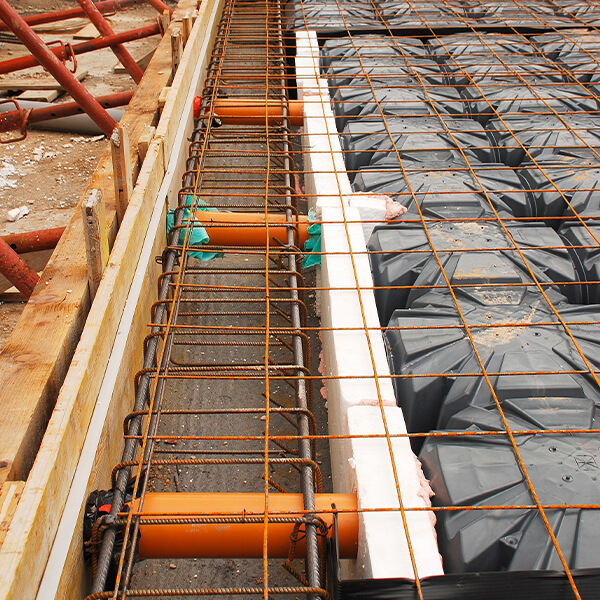What is a Sub-Slab Depressurization System?
Like other radon mitigation systems, the objective of a sub-slab depressurization system is to prevent radon from infiltrating a building from beneath the soil or foundation. It consists of a fan or blower that draws air from the soil beneath a building and discharges it to the atmosphere through a series of collection and discharge pipes. The system typically involves cutting one or more holes through the building’s slab to place extraction pipes in contact with the subgrade materials just beneath the slab. These extraction points may also include horizontal extraction through foundation walls in some cases.
These systems create a negative pressure field directly under a building and on the outside of the foundation in relation to the building’s ambient pressure. The pressure field created by the extraction point in the slab extends upward adjacent to the foundation walls. This allows the system to draw soil gas from beneath the slab and exhaust it safely outside the building.
Preparation for Installation
Before installing a sub-slab depressurization system, it is essential to identify all potential entry routes for radon and other VOC (volatile organic compound) contaminated soil gases. This includes cracks in concrete walls or slabs, gaps in fieldstone walls, construction joints between walls and slabs, space around utility pipes, open sumps, and other potential entry points.
Diagnostic testing is also a critical component of preparation for system installation. This testing is conducted by drilling small holes through the building slab, applying a vacuum to one hole, and measuring pressure drops at surrounding test holes. This helps determine the number and location of extraction points needed for the sub-slab system.
Installation of Sub-Slab Depressurization System
The installation process for a sub-slab depressurization system can vary depending on the specific circumstances and design/construction of the building and the site. The following steps provide a general overview of the installation process:
1. Sub-Slab Soil Gas Sampling – Before installation, sub-slab soil gas sampling is conducted to assess the levels of radon or other volatile gases present and evaluate the potential risk.
2. Mitigation System Design – Based on the sampling results, if vapor intrusion is identified above the screening levels, a mitigation system should be put in place. The design of the system will consider factors such as building size, construction quality, and sub-slab material permeability.
3. Suction Point Installation – Suction points for the system can be created by coring through the slab or foundation, trenching in the slab, directional drilling from outside the building, or other methods to access the sub-slab soil. A typical installation involves a vertical pipe with a diameter of 3 to 6 inches, installed through a cored hole in the floor. A suction pit or cavity is created below the floor by removing approximately 1 cubic foot of soil or fill material to reduce resistance to flow and enhance vacuum propagation. The piping is sealed to the slab or foundation at the connection point using durable caulking or air-tight pipe fittings.
4. System Components – The system components include an electric fan or blower that is connected via piping to the suction points beneath the slab. The fan or blower can be installed either outside or inside the building, depending on the available space and other factors. The vent pipe from the fan is exhausted above the roofline and away from building openings to prevent re-entrainment of vapors.
5. Monitoring & Maintenance – The system includes monitoring devices such as a permanent u-tube manometer, vacuum gauge, or pressure sensor to measure system pressures. Balancing valves may also be included to adjust system flow from multiple suction points and account for changes in pressure gradients over time. Regular maintenance and monitoring of the system are essential to ensure its continued effectiveness and should be made part of an OM&M plan.
Advantages of Sub-Slab Depressurization
When it comes to active radon mitigation, sub-slab depressurization systems offer several advantages:
Reliability – When professionally designed and installed in line with AARST’s standards, sub-slab depressurization is considered a reliable and protective method for mitigating radon intrusion.
Continuous Monitoring – The system’s performance can be continuously monitored by measuring sub-slab pressure differentials, reducing the need for expensive sampling.
Low Operational Costs – In-line fans used in sub-slab depressurization systems consume a small amount of electricity and require low routine maintenance, resulting in low operating costs.
Protection Against Multiple Contaminants – Sub-slab depressurization systems can protect buildings from radon and reduce moisture levels in basements, in addition to mitigating VOC vapors.
Versatility – Sub-slab depressurization systems can be implemented in various building types, including existing and new construction, residential homes, and larger commercial/industrial buildings.
Professional Radon Mitigation Services
Interested in seeing if a sub-slab depressurization system is right for your home or business? Contact the NRPP-certified radon measurement professionals at Southwest Radon Eliminators! We provide comprehensive inspections, testing, and mitigation services for residential and commercial properties including new construction.
